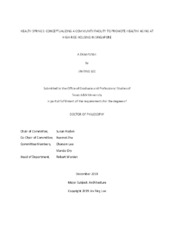| dc.description.abstract | Background and Aims: Due to land constraints and a rapidly aging population, innovative design solutions are needed to improve the situation of eldercare in Singapore. This study explored an “Aging in Place” strategy based on existing public housing neighborhoods to promote healthy aging for older Singaporeans. The researcher proposed and evaluated the feasibility of a new type of community facility (the Health Springs) to be located in the existing unused ground floor area of high-rise public housing buildings. Methods: This design-based, mixed-methods study sequentially used focus groups and design workshops for grounded data collection and prototype development, followed by a cross-sectional survey to evaluate the potential use of the proposed Health Springs. Results: Focus group discussions with healthcare workers and older adults (n=38) suggested the need for a highly accessible community facility to increase space for caregiver assistance and improve older adults’ autonomy and health, emphasizing social connections beyond the family. Using the focus group findings, the design workshops with healthcare professionals (n=12) developed the proposed Health Springs facility, which included six different activity spaces to potentially support healthy aging. In the cross-sectional survey of public housing residents and design professionals (n=271), 81% of participants indicated they were likely to use the proposed Health Springs, with a perceived usability score (67.9/100) that strongly predicted the overall likelihood of using the Health Springs (p<0,0001). Expected health outcomes related to increased physical activity (p= 0.003) and likely use of individual spaces - a Garden Café (p= 0.0008), and Personal Care Room (p= 0.005) strongly predicted participants’ expected usage of the facility. Implications: Because of the availability of under-used ground floor area of homogeneous public housing buildings, the Health Springs is a feasible, innovative solution that potentially supports healthy aging in Singapore. This study assessed the impacts of perceived usability expected health outcomes, and likelihood of using specific spaces on the overall usage of the proposed facility.
These findings can improve the design process and quality of future facilities for aging, and may be adapted to comparable high-density urban settings, potentially improving health and quality of life for residents, caregivers, and family members. | en |


